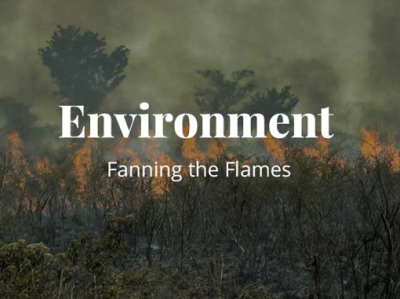Environment - Fanning The Flames

While we were writing this issue of our newsletter, we followed the news of the tragic wildfires that burned the village of Lahaina in Hawaii to the ground. Of this writing there are close to 100 people who are confirmed dead and the whole area surrounding the city has been burned to the ground. This follows five years when fires have ravaged forest lands and small towns around the world. The Lahaina fire was only challenged by the fire that devastated Paradise California in 2018 in terms of loss of life. We are rightfully saddened by these tragedies but not enough to talk clearly about their cause.
Over the years since the California fires, we have witnessed the largest bushfires in Australia as well as massive fires in the arctic, the Amazon, Washington, Oregon, and Central Asia. Already this year Greece, Spain, Italy and Portugal have experienced unprecedented fire seasons and the predictions are there are more to come.
These fires are the result of the hottest temperatures recorded since the 1800’s. Lack of rain leading to drought, exceeding drying out of brush and forests and grass lands have created a perfect tinder box for present and future fires. It is difficult to ignore these unique conditions, yet some will.
The human effect on climate is creating unpredictable and extreme conditions. They reflect not only the increase in hot temperatures, but also unpredictable climate influences caused by warming oceans, extreme storms, and wind conditions. All of these create effects beyond human control.
The fires, and floods and storms all displace populations destroy valuable forests, kill animals and lay down conditions which will make the following seasons worse.
Air temperatures on Earth have been rising since the Industrial Revolution. While natural variability plays some part, the greatest influences are human activities. It is the release of greenhouse gases that trap heat and warm the planet that lie at the foundation of these events.
According to Dr Matthew Kasoar at Imperial College’s Leverhulme Centre for Wildfires, Environment and Society, the tinder-dry conditions would make it easier for them to spread.
He said: “Fire risk increases rapidly when there are periods of prolonged hot weather, which allow the soil and vegetation to completely dry out.”
While we feel compassion for those who lost their lives in the burning of Lahaina and the destruction of that beautiful town, it is all a part of a larger tragedy. A tragedy of our own making. It is up to each of us to do our part to help heal the earth and both human and non-human life.
WHAT YOU CAN DO
The doubters and the cynics want us to take our eyes away from the roots of these problems. They want to distract us from the reality that is a global crisis of massive proportions. One of the greatest contributing factors to the breakdown of our healthy ecosystem is the effect of animal agriculture. Pollution to air, water, and soil result from our raising animals to eat and the growing of crops to feed them. Visit our website and learn how you can easily create a healthy vegan diet and become part of the solution, not the problem.

